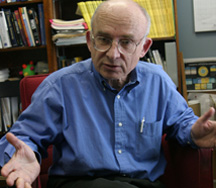Hans von Baeyer: Primed for conversation
 Hans Christian von Baeyer, Chancellor Professor of Physics, is more
than primed for serious conversation. Ever since the Einstein
centennial in 1979, when he published that little piece about general
relativity in the “William and Mary Gazette”—it won the Science Writing
Award from the American Institute of Physics—he has honed wit and
wonder to become one of America’s most engaging popularizers of
physics. During the ensuing three decades, he has made it his work to
talk, to write and to explain the nature of things. Today, roughly 70
articles, a couple of television series and five books later, it has
proved to be a fitting vocation.
Hans Christian von Baeyer, Chancellor Professor of Physics, is more
than primed for serious conversation. Ever since the Einstein
centennial in 1979, when he published that little piece about general
relativity in the “William and Mary Gazette”—it won the Science Writing
Award from the American Institute of Physics—he has honed wit and
wonder to become one of America’s most engaging popularizers of
physics. During the ensuing three decades, he has made it his work to
talk, to write and to explain the nature of things. Today, roughly 70
articles, a couple of television series and five books later, it has
proved to be a fitting vocation.
“I have been a teacher all my life; you teach at various levels,” he explains. “You teach at the public-school level, you teach at the university level, you teach at graduate school and you teach the public at large. It’s all a matter of explaining science—physics in particular—to the world.”
Having stayed, he has continued to be a force at the College. Those few who somehow have managed to avoid learning science from him either through his writings or in his classrooms may have encountered his intellectual curiosity at the Raft Debate, a dormant College tradition that he revived several years ago.
“The best students get it,” he said about the debates, annual spoofs that pit representatives of the academic disciplines against each other in frenzied harangues as they argue for their virtual lives. “The best students understand that a geology professor who is up there waving around a chainsaw is convinced deep down that geology is important, that understanding the earth that we’re standing on is important for humanity and important for life.” He calls the debates a mature way of looking at the world—“a symptom of the maturity of William and Mary.”
He has seen the institution grow to support that maturity. Thirty-six years ago, it was a small liberal-arts college; now it is a strong liberal-arts college within a university, he says. Through it all, he has witnessed a faculty that is “getting better,” and he has applauded the internationalization of the place.
The students, however, remain the “great treasure” of William and Mary, he says. “We have wonderful students and that’s what it’s all about. I have enjoyed interacting with them. I love it when old students from many years ago send me an e-mail or something. That makes it all worthwhile. It means I’ve contributed to their lives.”
 Skip to main content
Skip to main content
